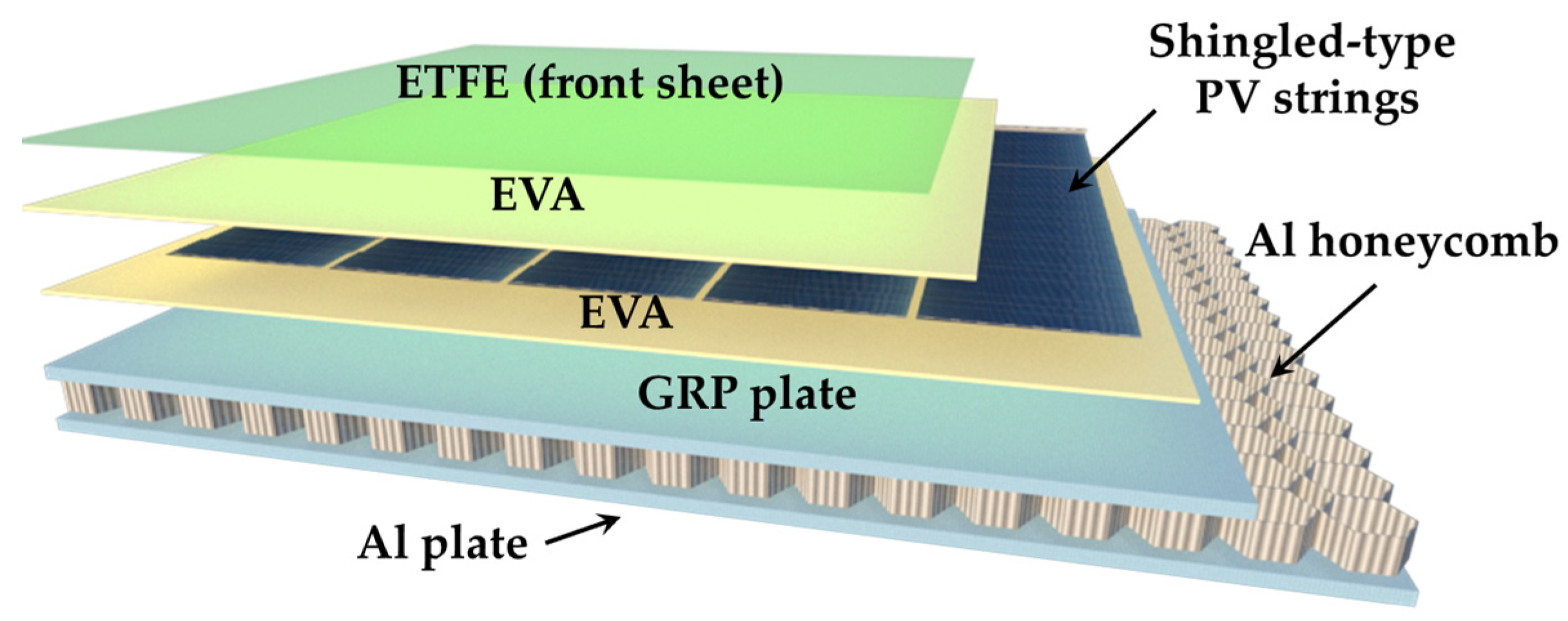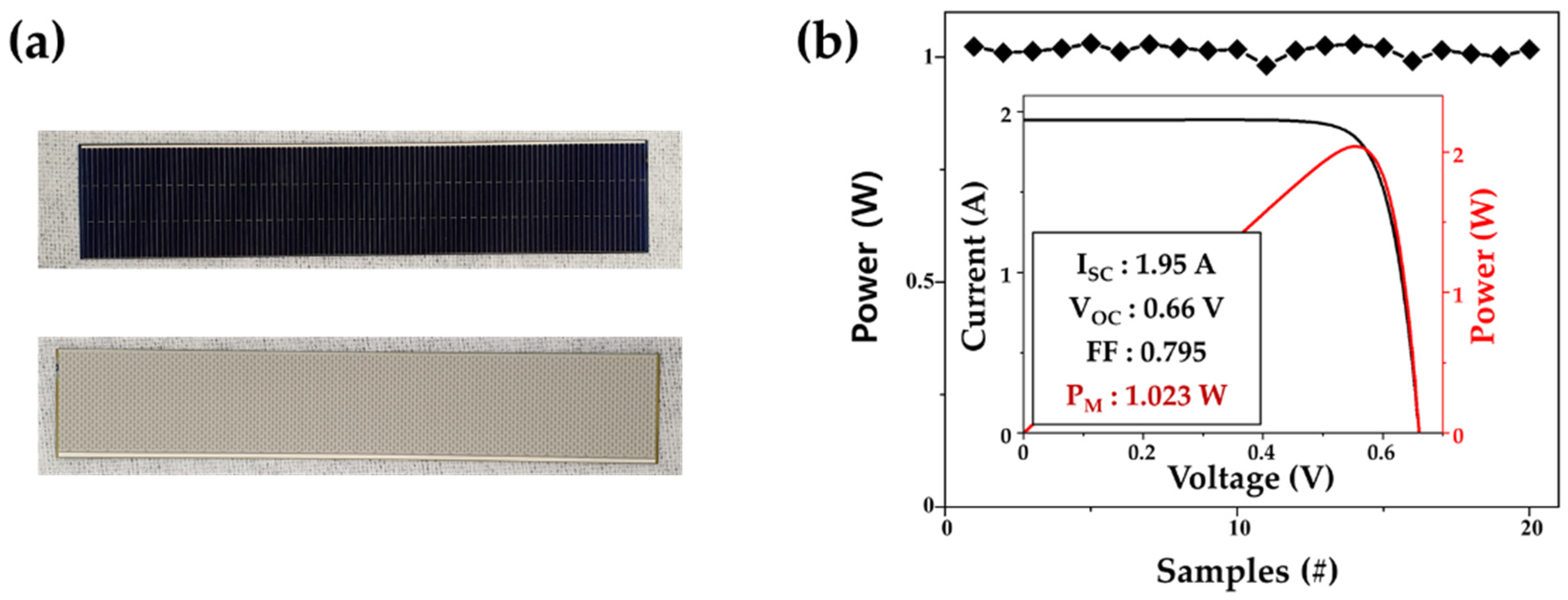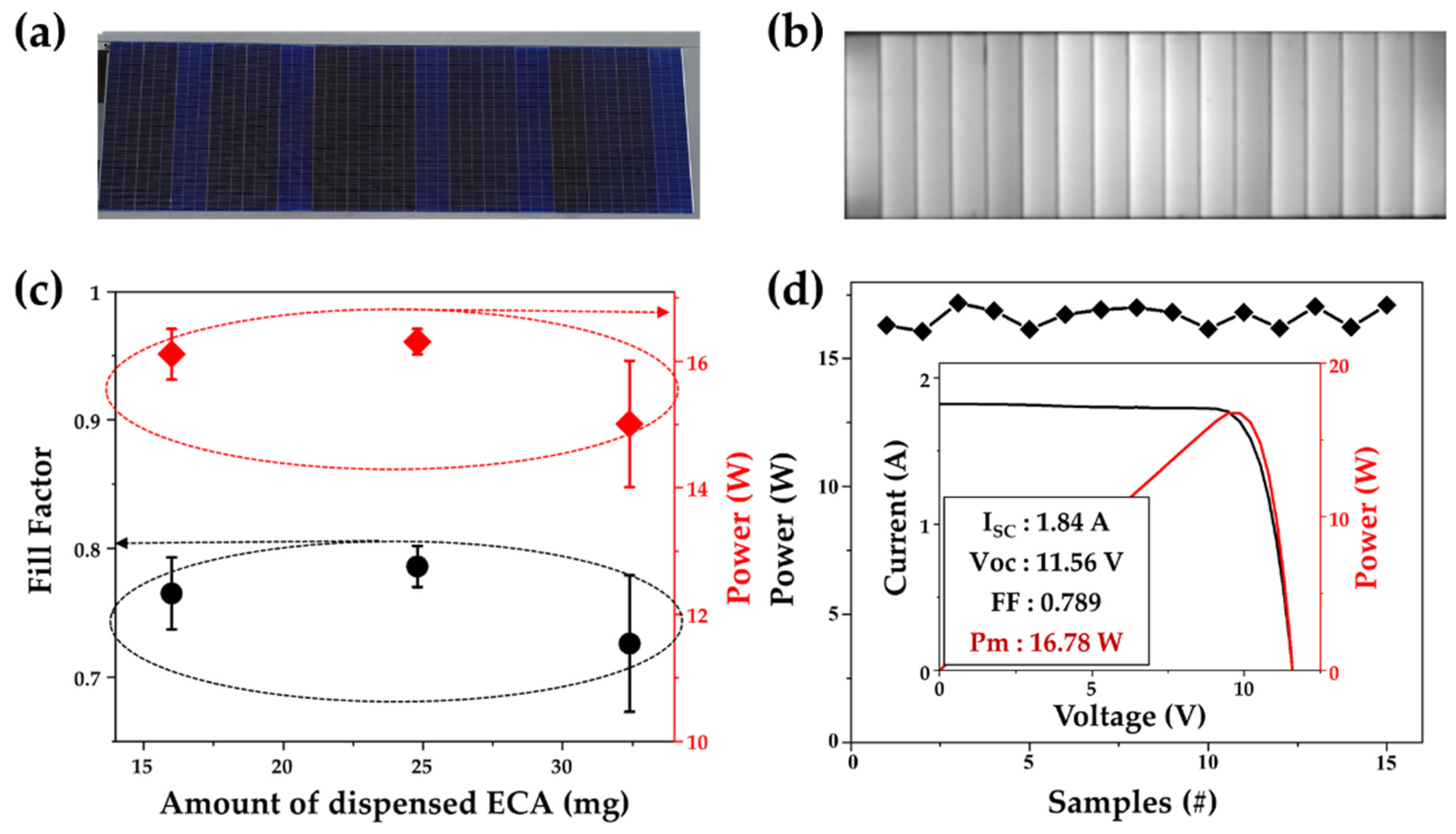Optimization of Shingled-Type Lightweight Glass-Free Solar Modules for Building Integrated Photovoltaics
Abstract
:1. Introduction
2. Materials and Methods
3. Results & Discussion
4. Conclusions
Author Contributions
Funding
Institutional Review Board Statement
Informed Consent Statement
Data Availability Statement
Conflicts of Interest
References
- Kuhn, E.T.; Erban, C.; Heinrich, M.; Eisenlohr, J.; Ensslen, F.; Neuhaus, D.H. Review of technological design options for building integrated photovoltaics (BIPV). Energy Build. 2021, 231, 110381. [Google Scholar] [CrossRef]
- Biyik, E.; Araz, M.; Hepbasli, A.; Shahrestani, M.; Yao, R.; Shao, L.; Essah, E.; Oliveira, A.C.; Caño, T.; Rico, E.; et al. A key review of building integrated photovoltaic (BIPV) systems. Eng. Sci. Technol. Int. J. 2017, 20, 833–858. [Google Scholar] [CrossRef]
- Li, C.; Wang, R.Z. Building integrated energy storage opportunities in China. Renew. Sustain. Energy Rev. 2012, 16, 6191–6211. [Google Scholar] [CrossRef]
- Ballif, C.; Perret-Aebi, L.; Lufkin, S.; Rey, E. Integrated thinking for photovoltaics in buildings. Nat. Energy 2018, 3, 438–442. [Google Scholar] [CrossRef]
- Reese, M.O.; Glynn, S.; Kempe, M.D.; McGott, D.L.; Dabney, M.S.; Barnes, T.M.; Booth, S.; Feldman, D.; Haegel, N.M. Increasing markets and decreasing package weight for high-specific-power photovoltaics. Nat. Energy 2018, 3, 1002–1012. [Google Scholar] [CrossRef]
- Nussbaumer, H.; Klenk, M.; Keller, N. Small unit compound modules: A new approach for light weight PV modules. In Proceedings of the 32nd European Photovoltaic Solar Energy Conference and Exhibition, Munich, Germany, 20–24 June 2016; pp. 56–60. [Google Scholar]
- Bittmann, E.; Mayer, O.; Zettl, M.; Stern, O. Low Concentration PV with Polycarbonate. In Proceedings of the 23rd European Photovoltaic Solar Energy Conference and Exhibition, Valencia, Spain, 1–5 September 2018; pp. 537–539. [Google Scholar]
- Drabczyk, K.; Sobik, P.; Starowicz, Z.; Gawlińska, K.; Pluta, A.; Drabczyk, B. Study of lamination quality of solar modules with PMMA front layer. Microelectron. Int. 2019, 36, 100–103. [Google Scholar] [CrossRef]
- Oreski, G.; Eder, G.C.; Voronko, Y.; Omazic, A.; Neumaier, L.; Mühleisen, W.; Ujvari, G.; Ebner, R.; Edler, M. Performance of PV modules using co-extruded backsheets based on polypropylene. Sol. Energy Mater. Sol. Cells 2021, 223, 110976. [Google Scholar] [CrossRef]
- Kajisa, T.; Miyauchi, H.; Mizuhara, K.; Hayashi, H.; Tokimitsu, T.; Inoue, M.; Hara, K.; Masuda, A. Novel lighter weight crystalline silicon photovoltaic module using acrylic-film as a cover sheet. Jpn. J. Appl. Phys. 2014, 53, 092302. [Google Scholar] [CrossRef]
- Nussbaumer, H.; Klenk, M.; Keller, N.; Ammann, P.; Thurnheer, J. Record-light weight c-Si modules based on the small unit compound approach mechanical load tests and general results. In Proceedings of the 33rd European Photovoltaic Solar Energy Conference and Exhibition, Amsterdam, The Netherlands, 25–29 September 2017; pp. 146–150. [Google Scholar]
- Martins, A.C.; Chapuis, V.; Sculati-Meillaud, F.; Virtuani, A.; Ballif, C. Light and durable: Composite structures for building-integrated photovoltaic modules. Prog. Photovolt. Res. Appl. 2018, 26, 718–729. [Google Scholar] [CrossRef]
- Martins, A.C.; Chapuis, V.; Virtuani, A.; Li, H.; Perret-Aebi, L.; Ballif, C. Thermo-mechanical stability of lightweight glass-free photovoltaic modules based on a composite substrate. Sol. Energy Mater. Sol. Cells 2018, 187, 82–90. [Google Scholar] [CrossRef]
- Dickson, D.C.; Heights, P. Photo-Voltaic Semiconductor Apparatus or the Like. U.S. Patent 2938938, 31 May 1960. [Google Scholar]
- Park, M.; Song, J.; Jee, H.; Moon, D.; Jeong, C.; Jee, H. Improvement in the power of shingled-type photovoltaic module by control of the overlapped width. J. Korean Phys. Soc. 2020, 77, 1040–1043. [Google Scholar] [CrossRef]
- Springer, M.; Bosco, N. Linear viscoelastic characterization of electrically conductive adhesives used as interconnect in photovoltaic modules. Prog. Photovolt. Res. Appl. 2020, 28, 659–681. [Google Scholar] [CrossRef]
- Jee, H.; Lee, S.; Jeong, C.; Lee, J. Electrically conductive adhesives and the shingled array cell for high density modules. J. Nanosci. Nanotechnol. 2019, 19, 1360–1363. [Google Scholar] [CrossRef] [PubMed]
- Rabanal-Arabach, J.; Rudolph, D.; Ullmann, I.; Halm, A.; Schneider, A.; Fischer, T. Cell-to-module conversion loss simulation for shingled-cell concept. In Proceedings of the 33rd European Photovoltaic Solar Energy Conference and Exhibition, Amsterdam, The Netherlands, 25–29 September 2017; pp. 178–182. [Google Scholar]
- Park, J.; Oh, W.; Park, H.; Jeong, C.; Choi, B.; Lee, J. Analysis of solar cells interconnected by electrically conductive adhesives for high-density photovoltaic modules. Appl. Surf. Sci. 2019, 484, 732–739. [Google Scholar] [CrossRef]
- Haedrich, I.; Eitner, U.; Wiese, M.; Wirth, H. Unified methodology for determining CTM ratios: Systematic prediction of module power. Sol. Energy Mater. Sol. Cells 2014, 131, 14–23. [Google Scholar] [CrossRef]
- Wohlgemuth, J.H.; Kurtz, S. Reliability testing beyond qualification as a key component in photovoltaic’s progress toward grid parity. In Proceedings of the 2011 IEEE International Reliability Physics Symposium, Monterey, CA, USA, 10–14 April 2011; pp. 5E.3.1–5E.3.6. [Google Scholar]
- Mclntosch, K.R.; Powell, N.E.; Norris, A.W.; Cotsell, J.N.; Ketola, B.M. The effect of damp-heat and UV aging tests on the optical properties of silicone and EVA encapsulants. Prog. Photovolt. Res. Appl. 2011, 19, 294–300. [Google Scholar]
- Shi, X.-M.; Zhang, J.; Li, D.-R.; Chen, S.J. Effect of damp-heat aging on the structures and properties of ethylene-vinyl acetate copolymers with different vinyl acetate contents. J. Appl. Polym. Sci. 2009, 112, 2358–2365. [Google Scholar] [CrossRef]
- Wohlgemuth, J.H.; Petersen, R.C. Reliability of EVA modules. In Proceedings of the 23th IEEE Photovoltaic Specialists Conference, Louisville, KY, USA, 10–14 May 1993; pp. 1090–1094. [Google Scholar]





| ML 2400 | DH 1000 | TC 200 | ||||
|---|---|---|---|---|---|---|
| Before Test | After Test | Before Test | After Test | Before Test | After Test | |
| VOC (V) | 21.50 | 21.49 | 21.63 | 21.59 | 21.79 | 21.76 |
| ISC (A) | 10.71 | 10.74 | 10.99 | 10.84 | 11.04 | 10.88 |
| FF | 0.717 | 0.706 | 0.748 | 0.744 | 0.753 | 0.743 |
| PM (W) | 165.09 | 162.88 | 177.78 | 174.23 | 181.14 | 175.78 |
| PM loss | 1.34% | 2.00% | 2.96% | |||
Publisher’s Note: MDPI stays neutral with regard to jurisdictional claims in published maps and institutional affiliations. |
© 2022 by the authors. Licensee MDPI, Basel, Switzerland. This article is an open access article distributed under the terms and conditions of the Creative Commons Attribution (CC BY) license (https://creativecommons.org/licenses/by/4.0/).
Share and Cite
Park, M.-J.; Youn, S.; Jeon, K.; Lee, S.H.; Jeong, C. Optimization of Shingled-Type Lightweight Glass-Free Solar Modules for Building Integrated Photovoltaics. Appl. Sci. 2022, 12, 5011. https://doi.org/10.3390/app12105011
Park M-J, Youn S, Jeon K, Lee SH, Jeong C. Optimization of Shingled-Type Lightweight Glass-Free Solar Modules for Building Integrated Photovoltaics. Applied Sciences. 2022; 12(10):5011. https://doi.org/10.3390/app12105011
Chicago/Turabian StylePark, Min-Joon, Sungmin Youn, Kiseok Jeon, Soo Ho Lee, and Chaehwan Jeong. 2022. "Optimization of Shingled-Type Lightweight Glass-Free Solar Modules for Building Integrated Photovoltaics" Applied Sciences 12, no. 10: 5011. https://doi.org/10.3390/app12105011
APA StylePark, M.-J., Youn, S., Jeon, K., Lee, S. H., & Jeong, C. (2022). Optimization of Shingled-Type Lightweight Glass-Free Solar Modules for Building Integrated Photovoltaics. Applied Sciences, 12(10), 5011. https://doi.org/10.3390/app12105011






